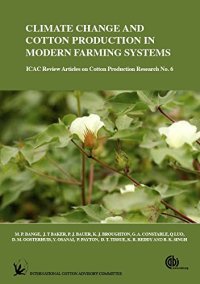
Ebook: Climate change and cotton production in modern farming systems
Author: Bange Michael P
- Tags: Cotton, Climatic factors., Crops and climate., Sustainable agriculture., Agricultural systems.
- Series: ICAC review articles on cotton production research No. 6
- Year: 2016
- Publisher: CABI
- Language: English
- pdf
Throughout the world cotton is broadly adapted to growing in temperate, sub-tropical, and tropical environments, but this may be challenged by future climate change. Production could be directly affected by changes in crop photosynthesis and water use due to rising CO2 and changes in regional temperature patterns. Indirect effects may result from a range of government regulations aimed at climate change mitigation. And while there is certainty that future climate change will impact cotton production systems; there will be opportunities to adapt.
This review provides details for the formation of robust frameworks to evaluate the impact of projected climatic changes, highlights the risks and opportunities with adaptation, and details the approaches for investment in research. Ultimately, it is a multi-faceted systems-based approach that combines all elements of the cropping system that will provide the best insurance to harness the change that is occurring, and best allow cotton industries worldwide to adapt. Given that there will be no single solution for all of the challenges raised by climate change and variability, the best adaptation strategy for industry will be to develop more resilient systems. Early implementation of adaptation strategies, particularly in regard to enhancing resilience, has the potential to significantly reduce the negative impacts of climate change now and in the future
This review provides details for the formation of robust frameworks to evaluate the impact of projected climatic changes, highlights the risks and opportunities with adaptation, and details the approaches for investment in research. Ultimately, it is a multi-faceted systems-based approach that combines all elements of the cropping system that will provide the best insurance to harness the change that is occurring, and best allow cotton industries worldwide to adapt. Given that there will be no single solution for all of the challenges raised by climate change and variability, the best adaptation strategy for industry will be to develop more resilient systems. Early implementation of adaptation strategies, particularly in regard to enhancing resilience, has the potential to significantly reduce the negative impacts of climate change now and in the future
Download the book Climate change and cotton production in modern farming systems for free or read online
Continue reading on any device:

Last viewed books
Related books
{related-news}
Comments (0)